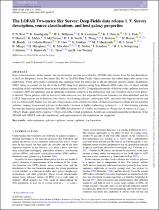| dc.contributor.author | Best, P N | |
| dc.contributor.author | Kondapally, Rohit | |
| dc.contributor.author | Jarvis, Matt | |
| dc.date.accessioned | 2023-07-04T08:08:46Z | |
| dc.date.available | 2023-07-04T08:08:46Z | |
| dc.date.issued | 2023 | |
| dc.identifier.citation | Best, P. N. et al. (2023). The lofar two-metre sky survey: Deep fields data release 1. V. Survey description, source classifications, and host galaxy properties. Monthly Notices of the Royal Astronomical Society, 523(2),1729–1755, https://doi.org/10.1093/mnras/stad1308 | en_US |
| dc.identifier.issn | 1365-2966 | |
| dc.identifier.uri | https://doi.org/10.1093/mnras/stad1308 | |
| dc.identifier.uri | http://hdl.handle.net/10566/9187 | |
| dc.description.abstract | Source classifications, stellar masses, and star-formation rates are presented for ≈80 000 radio sources from the first data release of the Low Frequency Array Two-metre Sky Survey (LoTSS) Deep Fields, which represents the widest deep radio surv e y ev er undertaken. Using deep multi-wavelength data spanning from the ultraviolet to the far-infrared, spectral energy distribution (SED) fitting is carried out for all of the LoTSS Deep host galaxies using four different SED codes, two of which include modelling of the contributions from an active galactic nucleus (AGN). Comparing the results of the four codes, galaxies that host a radiative AGN are identified, and an optimized consensus estimate of the stellar mass and star-formation rate for each galaxy is derived. Those galaxies with an excess of radio emission o v er that e xpected from star formation are then identified, and the LoTSS Deep sources are divided into four classes: star-forming galaxies, radio-quiet AGN, and radio-loud high-excitation and low-excitation AGN. Ninety-five per cent of the sources can be reliably classified, of which more than two-thirds are star-forming galaxies, ranging from normal galaxies in the nearby Universe to highly-starbursting systems at z > 4. Star-forming galaxies become the dominant population below 150-MHz flux densities of ≈1 mJy, accounting for 90 per cent of sources at S 150MHz ∼100 μJy. Radio-quiet AGN comprise ≈10 per cent of the o v erall population. Results are compared against the predictions of the SKADS and T-RECS radio sky simulations, and improvements to the simulations are suggested. | en_US |
| dc.language.iso | en | en_US |
| dc.publisher | Oxford University Press | en_US |
| dc.subject | Astronomy | en_US |
| dc.subject | Physics | en_US |
| dc.subject | Galaxies formation | en_US |
| dc.subject | Astrophysics | en_US |
| dc.subject | Radio continuum | en_US |
| dc.title | The lofar two-metre sky survey: Deep fields data release 1. V. Survey description, source classifications, and host galaxy properties | en_US |
| dc.type | Article | en_US |

